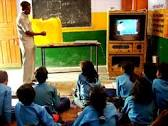I never fail to learn something when I mark assignments. This week my learning has been more pertinent than usual, as my roles of teacher and student sharply intersected.
The assignment required students to describe how and why they would improve their clinical service. One was a compelling narrative of cancer care in India, providing a window onto a societal and organisational culture well beyond my experience. In my other role as learner, I just happened to be reading Minds on Fire by Seely Brown and Adler (2008) , an article which referenced the Digital Study Hall (DSH) initiative in rural India. As my interest had already been piqued I decided to look further into this educational initiative.

The DSH is constructed upon a "hub and spoke" model to disseminate educational materials, using peripheral experts, not necessarily qualified teachers, reminiscent of a similar initiative in rural South Africa (Potter and Naidoo, 2006). The project team seem to accept from the outset that resources are scarce and unlikely to be forthcoming, so made use of the technological tools (such as telephony and dvds), systems and processes to hand - a concept termed as bricolage (Grint, 2008; Sharples et al, 2014). Thus DSH is an educational innovation that is surviving in a context challenged by the digital divide, paucity of expertise and huge demand.
The DSH website contains a page on research conducted through the project. These are reports rather than peer-reviewed publications and are somewhat biased in favour of the intervention. Furthermore, there is little evidence of the evaluation of outcome measures, although this may be due to prioritisation of limited resources towards provision rather than research.
Given my special interest in medical education, I was pleased to see that since the publication of Minds on Fire the project had expanded into public health education, through the Digital Polyclinic project, with focus on maternal and perinatal care. Despite all the obstacles inherent to the context, the DSH is an innovation with purpose that clinical education can look to for inspiration, whatever our discipline, location and geopolitics.
References:
- Grint, K. (2008) ‘Wicked problems and clumsy solutions: the role of leadership’, Clinical Leader, vol. 1, no. 2.
- Hilbert, M. (2011) ‘The end justifies the definition: The manifold outlooks on the digital divide and their practical usefulness for policy-making’, Telecommunications Policy, vol. 35, issue 8, pp. 715–736.
- Potter, C. and Naidoo, G. (2006) ‘Using interactive radio to enhance classroom learning and reach schools, classrooms, teachers, and learners’, Distance Education, vol.27, no.1, pp.63–86.
- Seely Brown, J. and Adler, R. (2008) ‘Minds on fire: open education, the long tail and learning 2.0’, EDUCAUSE Review, vol. 43, no. 1, pp. 16–32 [Online]. Available at http://net.educause.edu/ ir/ library/ pdf/ ERM0811.pdf (accessed 31 January 2016).
- Sharples, M., Adams, A., Ferguson, R., Gaved, M., McAndrew, P., Rienties, B., Weller, M. and Whitelock, D. (2014) Innovating Pedagogy 2014: Open University Innovation Report 3, Milton Keynes: The Open University.